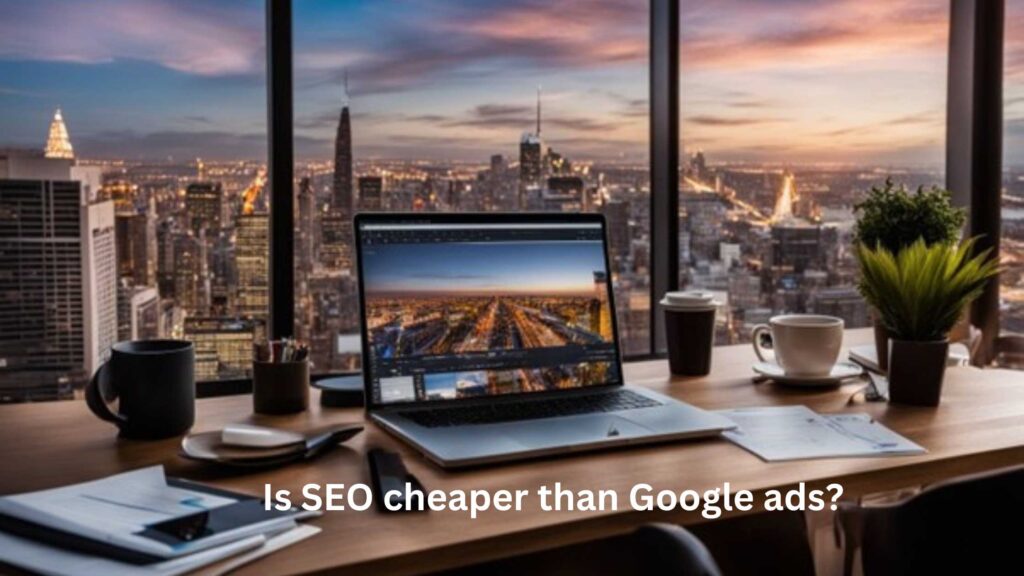
Choosing between SEO and Google Ads can feel like a puzzle. Did you know businesses spend a lot of money on both to get more website visitors? This article will show you how to decide which is better for you in a simple way.
Keep reading, it’s interesting!
Defining SEO and Google Ads
Incorporating SEO into your website strategy can significantly boost your organic search visibility, while Google Ads provide a paid alternative for reaching potential customers. Combining these approaches helps cover both organic and paid search results. By partnering with an SEO optimization expert, you can ensure that your website is optimized for long-term success in search rankings.
What is SEO?
SEO stands for Search Engine Optimization. It’s a digital marketing strategy aimed at improving a website’s visibility in search engine results pages (SERPs). By optimizing content, utilizing keywords, and building backlinks, businesses increase their site’s relevance and authority.
This process helps draw more organic traffic from people searching online.
SEO is the art of making your website more appealing to search engines and your target audience.
What are Google Ads?
Google Ads enables businesses to target potential customers through carefully selected keywords, driving traffic to their websites. However, combining paid advertising with organic efforts like SEO can provide a more sustainable strategy. Mastering both approaches, as outlined in Selling SEO, ensures long-term visibility and client satisfaction in search rankings.
This is known as PPC or pay-per-click advertising because businesses only pay when someone clicks on their ad.
Creating an effective campaign involves selecting the right keywords, setting a budget, and crafting ads that appeal to the target audience. The success of these campaigns can be measured through metrics like click-through rates, cost per click, and conversion rates.
Google also assigns a Quality Score based on the relevance and quality of the ads and landing pages, which affects how frequently the ads are shown and at what cost.
Comparing SEO and Google Ads
SEO and Google Ads have distinct differences that affect their effectiveness. One is organic, relying on search engine rankings, while the other relies on paid advertisements for visibility.
Differences Between SEO and Google Ads
Exploring the distinctions between SEO and Google Ads reveals a landscape of digital marketing strategies each with its unique benefits and applications. Here’s a concise comparison:
Aspect | SEO (Search Engine Optimization) | Google Ads |
Primary Focus | Improving website ranking in organic search results. | Displaying paid ads atop or alongside organic search results. |
Cost | Costs accrue from optimization efforts over time; no direct payment to search engines. | Cost-per-click (CPC) model; advertisers pay for each click on their ads. |
Time for Results | Long-term strategy; takes weeks to months for significant impact. | Immediate visibility; ads can appear as soon as the campaign starts. |
Target Audience | Targets users looking for information or solutions organically. | Targets specific demographics, interests, and behaviors through paid strategies. |
ROI Tracking | Challenging to measure directly; relies on organic traffic and conversions over time. | Easier to track with detailed metrics on ad spend, clicks, and conversions. |
Visibility | Depends on content quality, keywords, and SEO practices. | Highly visible, paid placements above organic search results. |
Sustainability | Benefits can last long after initial efforts, with ongoing maintenance. | Visibility stops when ad spend stops. |
Flexibility | Requires time to adapt to changes in search engine algorithms. | Ads can be quickly adjusted, paused, or refined for targeting. |
This table lays out the foundational differences between SEO and Google Ads, guiding businesses in making informed decisions tailored to their goals and budgets.
The Pros and Cons of SEO
When it comes to the realm of online marketing, SEO offers a range of benefits:
- Increased organic traffic
- Cost – effectiveness in the long run
- Potential for long – term results
- Enhanced website credibility and authority
However, it is important to note that SEO also has its drawbacks:
- Time – consuming process to achieve results
- Everchanging search engine algorithms
- Requires constant optimization and monitoring
The Pros and Cons of Google Ads
In addition to boosting immediate visibility, Google Ads can complement a strong SEO strategy by driving targeted traffic while your organic rankings build over time. For those exploring career opportunities in digital marketing, learning SEO can open doors to a wide range of possibilities, including SEO careers in high-demand industries.
However, the effectiveness of Google Ads is contingent on continuous monitoring and adjustment to ensure optimal performance, which requires time and expertise. Advertisers also need to compete in a bidding system based on keywords, leading to increased costs for popular search terms. Furthermore, managing ad campaigns demands constant attention and analysis to avoid overspending or reaching an irrelevant audience.
In sum:
- Immediate visibility on search engines
- Precise audience targeting options
- Flexible budgeting and cost control
- Detailed performance metrics and insights
- Continuous monitoring and adjustment required
- Increased costs for popular search terms
- Demand for constant attention and analysis
Deciding Between SEO and Google Ads
When choosing between SEO and Google Ads, consider your long-term goals. They both have their strengths and weaknesses, so understanding your priorities will help in making the best decision for your business.
When to Choose SEO?
SEO should be chosen when seeking organic, long-term visibility on search engines. It is cost-effective and sustainable, especially for businesses with a limited budget. SEO can improve brand credibility, attracting targeted traffic through relevant keywords and phrases to boost website rankings on search engine results pages.
Additionally, it ensures continual visibility even if the advertising budget runs dry.
To execute an effective SEO strategy, conducting meticulous keyword research and creating high-quality content tailored towards users’ intent is crucial. This underpins a successful SEO campaign that adapts to the ever-changing algorithms of search engines like Google.
Not only does it enhance website visibility but also builds brand authority within the realm of online marketing.
When to Choose Google Ads?
Google Ads is most suitable for businesses seeking quick and measurable results. It is advisable when aiming to target specific audiences using keywords, demographics, or interests.
By utilizing Google Ads, businesses can increase their visibility in search engine results pages and reach potential customers at the exact moment they are searching for related products or services.
Moreover, it’s not merely about increasing brand awareness; Google Ads focuses on driving traffic and conversions with cost-efficient strategies.
SEO and Google Ads Working Together
SEO and Google Ads can complement each other in driving traffic to your website. Combining the two strategies ensures visibility on both organic search results and paid advertising, maximizing your online presence.
How Google Ads Can Boost an SEO Campaign
Google Ads can complement an SEO strategy by increasing visibility in search results. Utilizing Google Ads alongside SEO efforts can ensure that a business appears at the top of search engine results pages, enhancing brand exposure and attracting more potential customers.
By strategically targeting keywords through paid advertising, businesses can reach a wider audience and drive traffic to their website, thereby boosting the overall impact of their SEO campaign.
The integration of Google Ads with an SEO campaign provides immediate visibility for selected keywords while also building organic rankings over time. This combination allows businesses to expand their online presence and attract more qualified leads, resulting in a comprehensive and effective digital marketing strategy that maximizes both short-term and long-term results.
The Benefit of Using Remarketing to Increase Conversion Rates
Remarketing can be a powerful tool for increasing conversion rates. By targeting users who have previously visited your website, you can stay top-of-mind and encourage them to return to complete a purchase or take desired actions.
This personalized approach has been shown to lead to higher engagement and improved conversion rates, making it a valuable strategy in any digital marketing campaign.
Utilizing remarketing allows businesses to reach potential customers who have already shown an interest in their products or services. This targeted approach ensures that marketing efforts are directed towards individuals who are more likely to convert, ultimately maximizing the effectiveness of advertising spend.
Conclusion
In wrapping up, consider the strengths and weaknesses of each approach. Ultimately, it’s essential to carefully match your strategy with your goals. Don’t overlook the potential synergies when using both methods simultaneously.
By combining SEO and Google Ads effectively, you can maximize your online visibility and drive more traffic to your website. Keep experimenting to find what works best for you!

